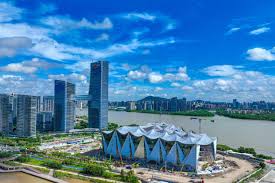Foreign
Guangdong-Hong Kong-Macao Greater Bay Area sees vital scientific innovation

By He Linping, Jiang Xiaodan, People’s Daily
At 8 a.m., Zhong Chao, founder of PAM²L Biotechnologies, a developer of innovative, low-cost, and sustainable functional biomaterials, was already busy at work in Guangming Science City, a comprehensive national science center in Guangming district, Shenzhen, south China’s Guangdong province.
Zhong, also a researcher at the Shenzhen Institute of Advanced Technology, Chinese Academy of Science, has now become a pioneering entrepreneur in the fertile “test field” of industrial innovation.
In 2019, Zhong research revealed that feeding probiotics to nematodes extended their lifespan by regulating mitochondrial function through a bacterial enzyme. “Applying this mechanism to human cells,” Zhong said, “could yield breakthrough anti-aging compounds.”
Guided by this insight, his team used synthetic biology to engineer a bacterial strain capable of mass-producing the enzyme.
Early R&D required cross-disciplinary collaboration among microbiologists and materials scientists Guangming’s integrated ecosystem – where research institutes and businesses share facilities – enabled real-time calibration of technical parameters with engineers. Within three years, laboratory discoveries advanced to mass production.
“From nematode longevity studies to commercial anti-aging ingredients and medical-grade biomaterials, this progress was made possible by the Guangdong-Hong Kong-Macao ‘innovation relay,'” Zhong emphasized. “That’s why we chose this base.”
“This base” extends beyond Guangming Science City. Northwest, the Pearl River Estuary connects Dongguan and Guangzhou; southward, it links Shenzhen and Hong Kong – forming a 100-kilometer innovation corridor.
Leveraging geographic advantages, robust resources, and the Guangdong-Hong Kong-Macao Greater Bay Area’s ongoing development as an international tech hub, the region now concentrates innovation entities and expertise, creating a dynamic synergy along the Guangzhou-Shenzhen-Hong Kong scientific innovation corridor.
In September, the World Intellectual Property Organization released the Global Innovation Index 2025, ranking the “Shenzhen–Hong Kong–Guangzhou” cluster as the world’s largest innovation hub—surpassing Japan’s “Tokyo–Yokohama” cluster for the first time.
In Guangming district, PAM²L Biotechnologies is not alone. Another company, Liying Biotech, produces recombinant collagen proteins with triple-helix structures. Many of its founding members brought cutting-edge theoretical expertise to Guangming, and after achieving breakthroughs in pilot trials, they confidently handed over industrialization to manufacturing partners “along the same corridor.”
“The Pearl River Delta offers mature precision-instrument supply chains,” a Liying representative stated, highlighting a Dongguan-made protein purification system costing 1/20 of imported equivalents while outperforming them. “This R&D-manufacturing synergy boosts our competitiveness.”
“When scientific research, industry, policy, and the market work hand in hand, ideas from the lab can quickly bear industrial fruit,” said Zhang Guangnan, a professor at the Institute of Guangdong, Hong Kong and Macao Development Studies, Sun Yat-sen University.
“What drives this is not only geographic proximity and complementary strengths, but also the free flow of innovation factors across the corridor,” Zhang added.
This summer, Signet Therapeutics drew global attention with its targeted therapy for diffuse gastric cancer. COO Dai Changgui explained: “Our AI algorithms screen billions of molecules to pinpoint tumor-weakness compounds, slashing drug development time.”
In 2020, founder Zhang Haisheng of Signet Therapeutics returned to Shenzhen from overseas with his research vision. Thanks to the Hetao Shenzhen-Hong Kong Science and Technology Innovation Cooperation Zone’s unique location and supportive policies, his team quickly grew to include over 80 percent R&D personnel, nearly 70 percent of whom hold master’s or doctoral degrees.
“This place is like a powerful magnet,” Dai noted. “International experts can easily travel between Shenzhen and Hong Kong through fast channels, while the Greater Bay Area’s well-developed industrial ecosystem doubles our experimental efficiency.”
On June 27 this year, the Greater Bay Area International Clinical Trials Center of the Shenzhen Medical Academy of Research and Translation was officially inaugurated. Focusing on building a closed-loop clinical trial ecosystem across the region, the center effectively integrates clinical research resources.
According to its director, Li Yichong, by enabling resource sharing and efficient collaboration, the center will help turn the Greater Bay Area into a major global source of biomedical innovation.
In recent years, Guangdong province has developed 26 key innovation platforms along the scientific innovation corridor. In 2024, innovation entities within these platforms accounted for about 1/10 of the province’s total PCT patent applications. Cities, parks, major facilities, and laboratories along the corridor, like pearls strung together, are shining ever more brightly as the corridor’s innovation vitality continues to surge.
Foreign
Understanding China’s urban development through a Chinese perspective

By Wu Yan, People’s Daily
From the ancient wisdom in Kaogong ji, or The Artificer’s record, the earliest Chinese book on technologies which describes how craftsmen build the state, to the Athens Charter that defines the functions of a modern city, humanity’s pursuit of the ideal city has spanned millennia.
China’s current efforts to build people-centered smart cities, aligned with the vision of making cities better places to live, reveal distinctive perspectives on urban development.
The first lies in its foundational philosophy: Cities are built by and for the people defines the essence of China’s approach to urban modernization.
In Shanghai’s Xuhui Riverside, foreign expert Kseniia Kirianaki observed how prime riverfront area was preserved as public space rather than becoming commercial or luxury residential zones. It’s truly remarkable, she said.
From building twin hills in the city center based on citizens’ suggestions to building apartment blocks for food delivery riders, Shanghai consistently prioritizes people in its planning, reserving premium resources for the public use and ensuring equitable access to services. The people’s city ethos shines vividly here.
Nationally, cities embrace this same principle. Beijing has implemented detailed underground space development plans, while Guangzhou expands its network of public cultural facilities.
Urban planning now begins with residents’ actual needs; city construction emphasizes livability and employment; governance fosters collective participation and shared benefits. Though cities express this warmth differently, all share the core commitment: only by building foundations for better lives can citizens’ sense of fulfillment, happiness, and security truly flourish.
The second perspective is evident in practice. China’s pursuit of high-quality, connotative urban development is charting a new course for people-oriented modernization.
Visitors to Chongqing’s digital urban operations center witness firsthand how integrated data systems underpin city management. In Fuzhou’s a historical and cultural area Sanfang Qixiang, which literally means three lanes and seven alleys, urban renewal has both preserved the city’s cultural heritage and improved residents’ quality of life. Similarly, Nanjing’s Tangshan Quarry Park exemplifies ecological restoration, transforming a former mining site into a thriving public green space – turning industrial scars into recreational havens.
These cases illustrate the compelling demonstration effect of China’s high-quality urban development. As UN Under-Secretary-General Anaclaudia Rossbach noted, China’s experience offers valuable insights globally.
China’s cities have shifted from large-scale expansion to improving quality and efficiency, emphasizing intensive growth over extensive development. By focusing on the construction of modern cities of the people that are innovative, desirable to live in, beautiful, resilient, culturally advanced, and smart, China is refining its urban vision. This approach seeks efficient, distinctive, and well-coordinated progress to enhance the overall quality of urban life.
The third perspective lies in its global influence. China demonstrates its sense of responsibility by providing international public goods.
Take the concept of the 15-minute community life circle as an example. First proposed by Shanghai at the inaugural World Cities Day Forum in 2014, the concept quickly spread across the country. Later, Paris introduced its own 15-minute city plan, and Milan has been described by media as one of the cities closest to achieving that vision. This resonance shows how China’s ideas are inspiring global urban innovation.
China’s contributions go beyond concepts. The Shanghai Award has become a high-level UN recognition for urban sustainability achievements. The Shanghai Manual remains among the most downloaded publications from UN-Habitat , and the Shanghai Index is being piloted in cities across multiple countries. These efforts offer new solutions to urbanization challenges and highlight China’s responsibility and contribution as a major country.
Today’s China is committed to building a collaborative social governance system with broad participation, aiming to deliver benefits for all. The goal is to make cities true homes of happiness for their residents and ensure development brings tangible improvements to everyday life. This commitment resonates with historical aspirations while representing a significant contribution to global urban civilization.
Foreign
Spring manufacturer in E China finds its bounce on new track of growth

By Liu Junguo, People’s Daily
Recently, Le Zhiguo, head of the robotics spring task force at Zhejiang Meili High Technology Co., Ltd. (Meili), visited several humanoid robot companies, including Unitree Robotics and Deep Robotics.
“Our purpose was to deliver prototype springs and deepen collaboration with downstream partners to jointly overcome technical hurdles,” stated Le.
Le explained that while many humanoid robot developers concentrate on core components like control systems (“brain”), motion coordination (“cerebellum”), and joint actuators, they often pay less attention to the flexibility of the body and limb systems. This oversight can result in operational issues such as overheating joints, unnatural movements, and reduced durability.
Recognizing this gap, Meili leveraged its expertise to assist. The company has already begun supplying small batches of prototype springs to several humanoid robot manufacturers. The solution for enhancing robotic flexibility and agility? A specialized spring, approximately one centimeter in diameter.
At first glance, this component may appear similar to conventional springs. “However,” Le clarified, “its strength and precision are significantly higher. When integrated into linear actuators, it enables smoother and more coordinated robotic movements.”
Le Zhiguo drew an analogy: if sensors provide a robot’s sense of touch and harmonic reducers function as its joints, then these high-precision, high-strength damping springs act like ligaments. They cushion joints, facilitate posture adjustment, and mitigate vibration and noise.
To accelerate this development, Meili established a dedicated robotics spring team earlier this year, drawing key technical experts from more than 120 R&D personnel. Within just three months, the team progressed from concept design to small-batch production, enabling Meili to supply springs to both domestic and international robotics companies.
How did the company manage to springboard into this new field so quickly?
“The foundation was built on over 35 years of experience in the spring industry,” explained Zhang Bihong, Founder and Chairman of Meili. “That solid expertise made our entry into a new sector possible.”
Founded in Ru’ao township, Xinchang county, east China’s Zhejiang province, Meili began as a small spring workshop. “We started by manufacturing springs for fire extinguishers, then progressed to motorcycle valve springs,” Zhang recalled.
In the early days, with few clients, Zhang often rode his bicycle along dusty country roads, visiting motorcycle parts factories one by one. Gradually, the company expanded into the automotive spring market.
In recent years, intensifying competition in the traditional spring market could no longer support the company’s growth ambitions. However, the rapid rise of China’s new energy vehicle (NEV) sector presented a new opportunity.
“To thrive, we had to ascend the value chain,” Zhang stated. Determined to move into higher-value products, he led the company to develop air suspension springs for NEVs – a segment with significantly higher technical barriers.
Air suspension systems, once exclusive to high-end vehicles, were long dominated by foreign companies. Despite having no prior experience in this field, the Meili team recognized that the market opportunity might be fleeting. The pressure to succeed was immense.
“The greatest challenge was improving the durability and air-tight sealing between the rubber airbag and the metal components. Both factors directly impact product quality,” said Li Xiaojun, head of the air spring project team.
“Another difficulty was ensuring stable performance under extreme conditions. Sometimes, lab data looked perfect, but during real vehicle tests, the damping materials failed to meet standards,” Li added.
“To enhance air-tightness and ensure the springs could withstand fatigue, heat, and cold, we tested more than 100 types of rubber materials,” Li explained. The team repeatedly refined designs, adjusted material formulas, optimized vulcanization processes, and tested structural options. After enduring 5.42 million cycles in rigorous alternating high- and low-temperature humidity tests, Meili successfully produced its first prototype air spring for passenger vehicles in 2024. The prototype passed customer validation later that year.
The company continues to innovate. “Robot springs offer even higher added value than automotive springs and could represent a new multi-billion-yuan market,” Zhang noted.
Through relentless innovation, this small component is springing into a world of broader possibilities.
Foreign
Three products that reveal China’s secret in exploring new frontiers of growth

By Li Hongxing, People’s Daily
Two recent developments in wind turbine blade technology have sparked considerable public interest. First, blade lengths have increased dramatically – from just over 30 meters to more than 150 meters – significantly boosting the power-generating capacity of individual turbines. Second, companies are pioneering innovative ways to recycle decommissioned blades, particularly those from the first generation of turbines now nearing the end of their service life. These retired blades are being transformed into eco-friendly products such as pallets and pedestrian walkways.
As blades grow longer and industry chains expand, new commercial models and development trajectories are emerging. During a recent visit to a blade manufacturing facility, a striking question arose as we stood before a massive 100-meter blade in production: “If blades keep getting larger and production volumes increase, won’t the market eventually become saturated? Where will future growth come from?”
A company representative expressed no such concerns. The firm had already mapped out a comprehensive post-production value chain, covering areas such as turbine operations, maintenance, and blade recycling – each representing a substantial market opportunity in its own right. This strategic expansion and diversification of business models demonstrates how companies are innovating to overcome perceived market limitations and sustain growth.
This raises a broader question: Markets exist – but how can companies access new growth opportunities? Instructive parallels can be drawn from three diverse products across different sectors.
Consider, for instance, the case of bottled water.
In the western mining area of Shuangyashan Mining Company in northwest China’s Heilongjiang province, high groundwater levels once posed serious challenges to coal mining. Guided by a commitment to green development and supported by technological innovation, the company implemented a “drain – purify – reuse” model. The purified water now serves multiple purposes: production processes, dust suppression, irrigation, and even a new mineral water product line. This initiative generates nearly 10 million yuan ($1.41 million) in annual revenue, transforming what was once hazardous mine water into a source of green vitality.
The question remains: Where is the market? Growth emerges through transformation. Whether upgrading traditional sectors or reshaping emerging ones, companies that refuse to settle and persistently pursue improvement and innovation discover new pathways with every problem solved and unlock fresh potential with every reform.
Development resembles digging a well, and the market is the spring: those willing to explore new directions and apply fresh thinking to familiar territory will always find a steady flow of opportunity.
Consider the case of a bus route. Recently, Shanghai J.Y Ba-Shi Passenger Transport (Group) Co., Ltd. launched a customized service enabling elderly passengers to travel directly to local food markets. This “food-focused” route has become a new offering supporting leisure and consumption. As high-speed rail expands and traditional long-distance coach services decline, tailored routes like these have gained popularity across the Yangtze River Delta. Their success lies in accurately identifying consumer needs, carefully designing routes, improving service quality, and strengthening stakeholder collaboration.
Where do such opportunities originate? They require attention to both regional trends and granular shifts. Young and old alike cherish the small joys of everyday life and appreciate accessible escapes close to home. When companies understand and meet these emotional needs, they tap into hidden market potential. Experience shows that through market-driven integration of cultural tourism, local products, and transportation resources, localized demand can become a growth driver, and regional micro-circulation can stimulate broader economic flows.
Finally, consider a screen protector. A company in central China’s Hunan province produces tempered glass screen protectors sold in 68 countries and regions, capturing 30% of the global market. Their competitive edge? Take fingerprint recognition sensitivity: through sustained R&D, they reduced protective film thickness from 0.33 millimeters to just 0.1 millimeters. By refining technology and strengthening their product, they generated tangible growth momentum.
The key lies not only in external drivers but in building inherent capabilities. From a single company to an entire region – and indeed, in forging a new development paradigm – continuous enhancement of internal resilience unlocks greater vitality. The stronger a company’s self-driven strength, the more competitive it becomes. When countless market entities thrive, they inject lasting momentum into China’s high-quality development.
China’s economy possesses a stable foundation, numerous advantages, remarkable resilience, and vast potential. The fundamental conditions and long-term positive trajectory supporting its growth remain unchanged.
Within transformation lies opportunity;in microeconomic circulation, hidden potential; through inner strength, sustainable growth. Rooted in practical experience and looking ahead, China is steadily opening new frontiers for development.
-

 Uncategorized5 years ago
Uncategorized5 years agoFG, states urged to harness flooding for ranching, others with technology – Agbaje
-

 Headlines10 years ago
Headlines10 years agoBreaking: EFCC seals Borno House of Assembly, as Hon members take to their heels
-

 News11 years ago
News11 years agoNigeria Security Operatives Stage Manhunt For Homosexual Perpetrator
-

 News9 years ago
News9 years agoHow 21-year-old Girl fled community over accusation of lesbianism
-

 News10 years ago
News10 years agoYobe Gov Moves Against Deputy
-

 Opinion7 years ago
Opinion7 years ago7 signs she has friend zoned you
-
Technology4 years ago
Online job placement company headhunts women
-

 Headlines9 years ago
Headlines9 years agoBorno Dep Gov Abducts Another Church Leader





